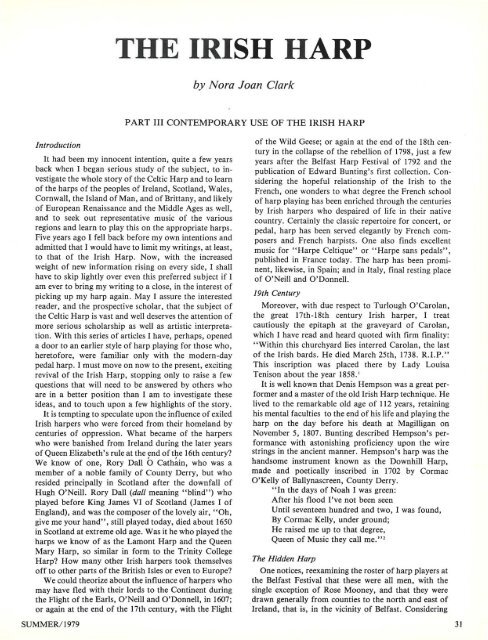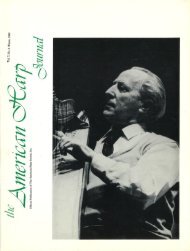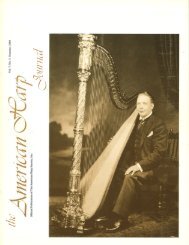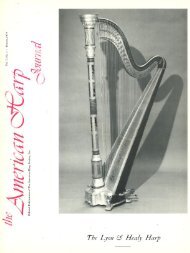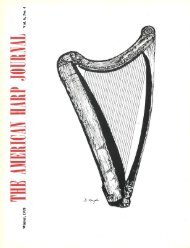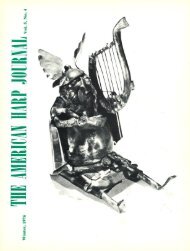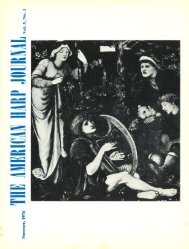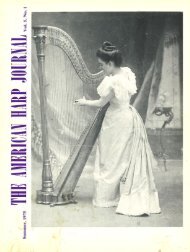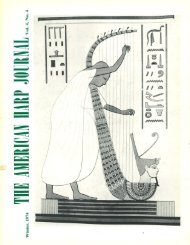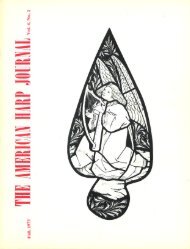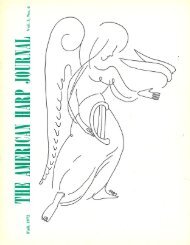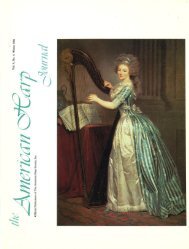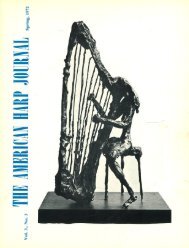AHJ, Vol. 7 No. 1, Summer 1979
AHJ, Vol. 7 No. 1, Summer 1979
AHJ, Vol. 7 No. 1, Summer 1979
You also want an ePaper? Increase the reach of your titles
YUMPU automatically turns print PDFs into web optimized ePapers that Google loves.
THE IRISH HARP<br />
by <strong>No</strong>ra Joan Clark<br />
PART III CONTEMPORARY USE OF THE IRISH HARP<br />
Introduction<br />
It had been my innocent intention, quite a few years<br />
back when I began serious study of the subject, to investigate<br />
the whole story of the Celtic Harp and to learn<br />
of the harps of the peoples of Ireland, Scotland, Wales,<br />
Cornwall, the Island of Man, and of Brittany, and likely<br />
of European Renaissance and the Middle Ages as well,<br />
and to seek out representative music of the various<br />
regions and learn to play this on the appropriate harps.<br />
Five years ago I fell back before my own intentions and<br />
admitted that I would have to limit my writings, at least,<br />
to that of the Irish Harp. <strong>No</strong>w, with the increased<br />
weight of new information rising on every side, I shall<br />
have to skip lightly over even this preferred subject if I<br />
am ever to bring my writing to a close, in the interest of<br />
picking up my harp again. May I assure the interested<br />
reader, and the prospective scholar, that the subject of<br />
the Celtic Harp is vast and well deserves the attention of<br />
more serious scholarship as well as artistic interpretation.<br />
With this series of articles I have, perhaps, opened<br />
a door to an earlier style of harp playing for those who,<br />
heretofore, were familiar only with the modern-day<br />
pedal harp. I must move on now to the present, exciting<br />
revival of the Irish Harp, stopping only to raise a few<br />
questions that will need to be answered by others who<br />
are in a better position than I am to investigate these<br />
ideas, and to touch upon a few highlights of the story.<br />
It is tempting to speculate upon the influence of exiled<br />
Irish harpers who were forced from their homeland by<br />
centuries of oppression. What became of the harpers<br />
who were banished from Ireland during the later years<br />
of Queen Elizabeth's rule at the end of the 16th century?<br />
We know of one, Rory Dall b Cathain, who was a<br />
member of a noble family of County Derry, but who<br />
resided principally in Scotland after the downfall of<br />
Hugh O'Neill. Rory Dall (da/1 meaning "blind") who<br />
played before King James VI of Scotland (James I of<br />
England), and was the composer of the lovely air, ''Oh,<br />
give me your hand", still played today, died about 1650<br />
in Scotland at extreme old age. Was it he who played the<br />
harps we know of as the Lamont Harp and the Queen<br />
Mary Harp, so similar in form to the Trinity College<br />
Harp? How many other Irish harpers took themselves<br />
off to other parts of the British Isles or even to Europe?<br />
We could theorize about the influence of harpers who<br />
may have fled with their lords to the Continent during<br />
the Flight of the Earls, O'Neill and O'Donnell, in 1607;<br />
or again at the end of the 17th century, with the Flight<br />
of the Wild Geese; or again at the end of the 18th century<br />
in the collapse of the rebellion of 1798, just a few<br />
years after the Belfast Harp Festival of 1792 and the<br />
publication of Edward Bunting's first collection. Considering<br />
the hopeful relationship of the Irish to the<br />
French, one wonders to what degree the French school<br />
of harp playing has been enriched through the centuries<br />
by Irish harpers who despaired of life in their native<br />
country. Certainly the classic repertoire for concert, or<br />
pedal, harp has been served elegantly by French composers<br />
and French harpists. One also finds excellent<br />
music for "Harpe Celtique" or "Harpe sans pedals",<br />
published in France today. The harp has been prominent,<br />
likewise, in Spain; and in Italy, final resting place<br />
of O'Neill and O'Donnell.<br />
19th Century<br />
Moreover, with due respect to Turlough O'Carolan,<br />
the great 17th-18th century Irish harper, I treat<br />
cautiously the epitaph at the graveyard of Carolan,<br />
which I have read and heard quoted with firm finality:<br />
"Within this churchyard lies interred Carolan, the last<br />
of the Irish bards. He died March 25th, 1738. R.I.P."<br />
This inscription was placed there by Lady Louisa<br />
Tenison about the year 1858.'<br />
It is well known that Denis Hempson was a great performer<br />
and a master of the old Irish Harp technique. He<br />
lived to the remarkable old age of 112 years, retaining<br />
his mental faculties to the end of his life and playing the<br />
harp on the day before his death at Magilligan on<br />
<strong>No</strong>vember 5, 1807. Bunting described Hempson's performance<br />
with astonishing proficiency upon the wire<br />
strings in the ancient manner. Hempson's harp was the<br />
handsome instrument known as the Downhill Harp,<br />
made and poetically inscribed in 1702 by Cormac<br />
O'Kelly of Ballynascreen, County Derry.<br />
"In the days of <strong>No</strong>ah I was green:<br />
After his flood I've not been seen<br />
Until seventeen hundred and two, I was found,<br />
By Cormac Kelly, under ground;<br />
He raised me up to that degree,<br />
Queen of Music they call me." 2<br />
The Hidden Harp<br />
One notices, reexamining the roster of harp players at<br />
the Belfast Festival that these were all men, with the<br />
single exception of Rose Mooney, and that they were<br />
drawn generally from counties to the north and east of<br />
Ireland, that is, in the vicinity of Belfast. Considering<br />
SUMMER/ <strong>1979</strong><br />
31


